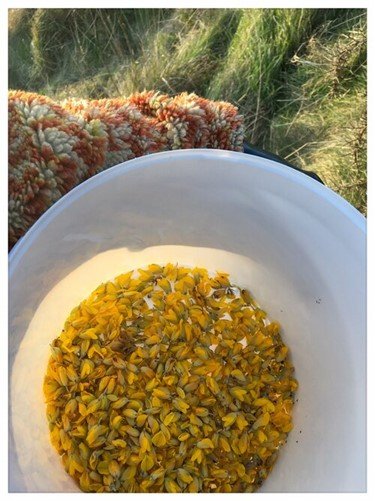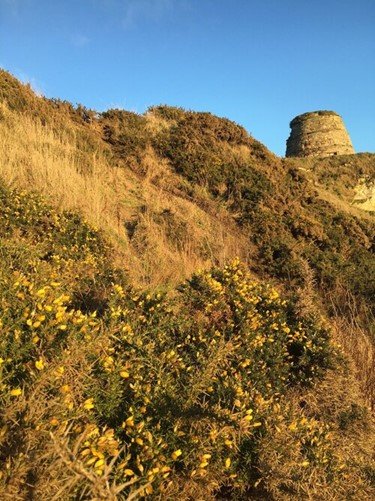When the Whin's in Bloom…
By Lucy Hine
For kissing there’s room…
Or so the Scottish saying goes.
Known as gorse and furze outside Scotland, whin flowers cover huge swathes of our coastlines for most of the year. They are so ubiquitous that they are sometimes taken for granted by locals and it often falls to visitors to point out how magnificent the bright yellow blossom is.
Whin flowers all year round here, even in the depths of winter, to avoid predation on its seeds during the spring and summer months. It’s a saviour for us in the leaner foraging months, when it’s a lot colder, and something we come back to time after time for its cheering yellow colour and delicious coconut aroma and taste.
The only small downside in foraging this one is the spiked branches the flowers grow on, which make any harvest a bit more of a challenge. We only ever gather small amounts at a time but even small amounts will take hours to gather (roughly 100g per person per hour).
If we worked in a bigger brewery, this beer would never make it off an idea sheet, as our time would have a cost attached to it, and a finance person would look at the plan and think it was all a bit of a bad idea. I would imagine that most of our ideas would be torn up by a finance person as it happens.
Delicate coconut-scented whin flowers have been used through the years to feed livestock and stoke fires, to dye woollens and stain eggs for rolling at Easter. They feature heavily in flower folklore and in some parts of the country, children believe that dragons are born in the buds.
Example of yarn dyed with flowers in Scotland. The middle one is dyed with whin. Image from ‘Flora Celtica’ by William Milliken & Sam Bridgewater.
On the West Coast, whin branches used to be brought into the house at the start of May by the youngest member of the family. They would be stuck in the roof to bring luck for the following year. This was called ‘bringing in the summer’. Here on the other side of the country the opposite is true. Most East Coast ladies of a certain age would be unlikely to accept a bloom to take into their houses in cases it brought them bad luck.
Luckily we are not superstitious so we brought the little flowers into our brewery in the depths of a cold snap this winter and used them in our latest beer which we’re releasing this week.
The beer is an organic wheat beer - hazy, refreshing, with lots of spice.
Alongside the wheat in the brew, we also used organic floor-malted barley and oats, and then whole leaf Pacific Gem hops. The musky spice and fruit typical of this style, develop naturally during primary fermentation.
Trying to get the delicate coconut flavour of the whin to manifest itself in this sort of beer is always a challenge. Certainly it’s not something that lasts at all well through the highs and lows in temperature during the brewday.
We’ve tried doing it several different ways, and have found that making a cold infusion and adding it after primary fermentation, before canning, goes a long to preserving the whin’s character. It’s subtle but comes through well on the finish.
This beer is available in limited quantities directly from us here (NOW SOLD OUT) or from our small but lovely list of independent stockists. Perfectly timed to ‘bring in the summer’.
Almost as though we planned it that way (which we didn’t, as those of you who know us will realise).






